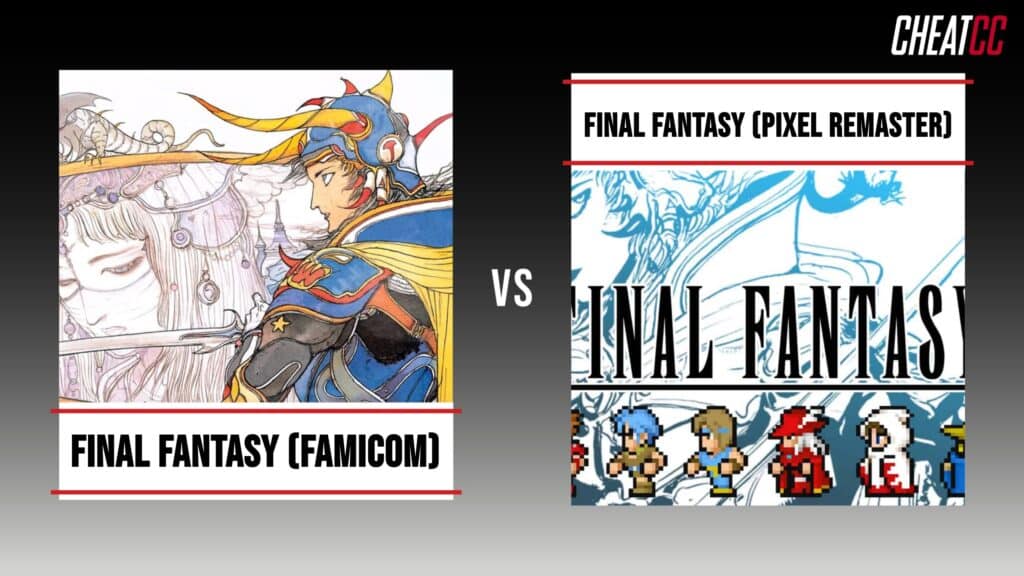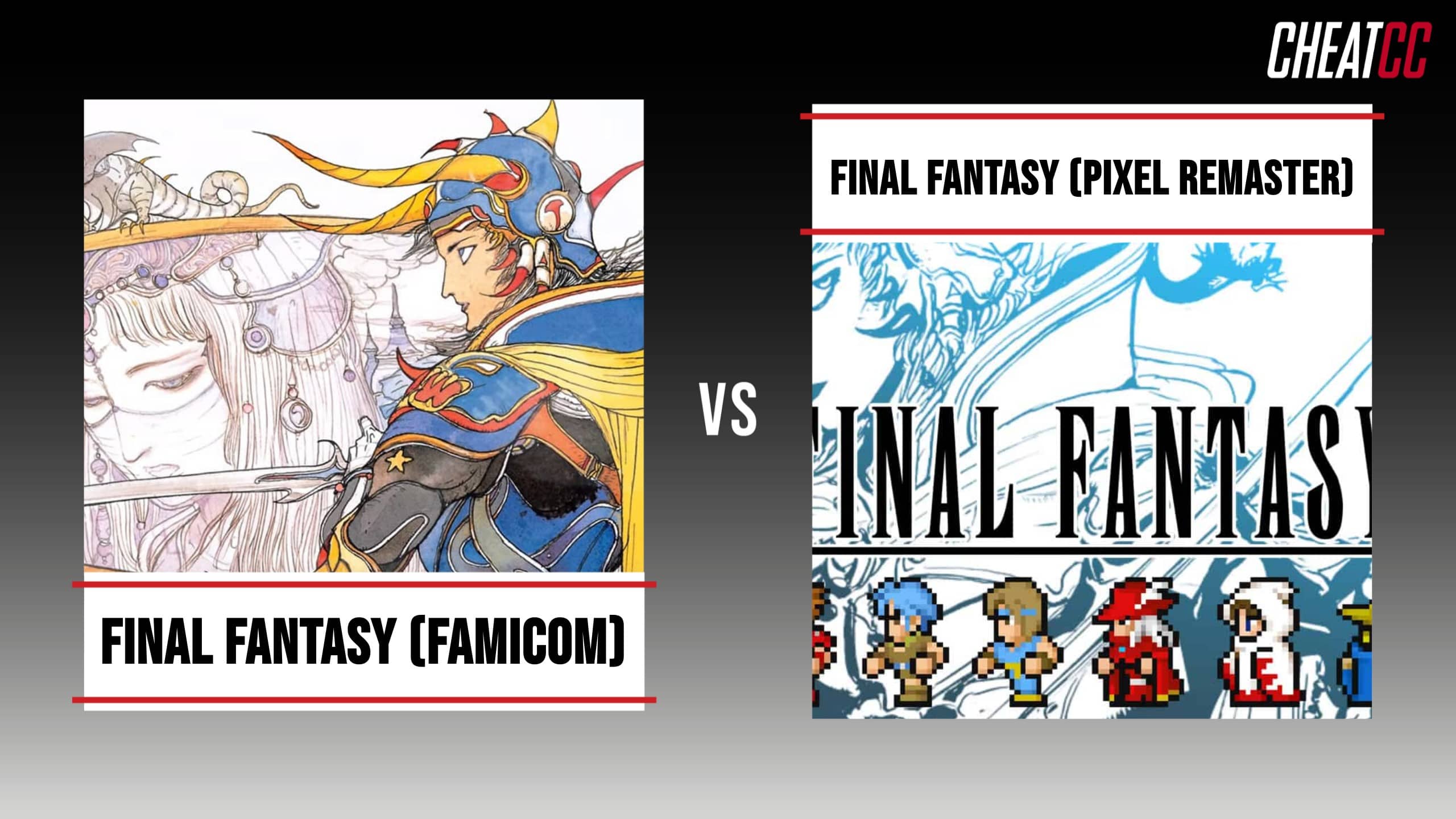As is the case with most successful franchises, the games in the Final Fantasy series have been subject to dozens of remakes, remasters, and ports throughout the years as a means to continually reintroduce the series to a new audience and update it for more modern, accessible platforms. The original Final Fantasy alone has more than 10 different versions across multiple hardware generations, illustrating the game’s timeless appeal and importance in establishing one of gaming’s most successful franchises. The recent Pixel Remasters series takes the first 6 games in the Final Fantasy franchise and makes them more consistent in terms of their presentation while also bringing them to modern consoles and PC. So, when pitting the original Final Fantasy vs the Final Fantasy Pixel Remaster, what are the differences?
First and foremost, the visual upgrade between the original Famicom/NES release of Final Fantasy and the newest Pixel Remaster version is significant. However, beyond mere audio-visual tweaks and quality-of-life upgrades, the Pixel Remaster version is significant mostly for how it somehow manages to make a 35-year-old game feel fresh again. Still, its polish and modernization come at the cost of it eschewing several updates made in previous re-releases, though some might argue that this adherence to the source material makes it the definitive re-imagining of the original game.
Final Fantasy vs Final Fantasy Pixel Remaster: Side-by-Side Comparison:

One of the first things fans will notice when comparing the original 8-bit release of Final Fantasy to the Pixel Remaster version are the changes to the game’s visual style. Rather than present the first three games in the series closer to their appearance on the Famicom, the Pixel Remaster versions of Final Fantasy, Final Fantasy II, and Final Fantasy III more closely resemble the same pixel art style that Final Fantasy IV and V use. As a result, there’s a visual consistency across the first 5 games in the Pixel Remaster series that didn’t exist previously, and it helps the first game in the series to feel less like an ancient relic while still remaining the timeless classic that it absolutely is.
| Characteristic | Final Fantasy (Famicom/NES) | Final Fantasy (Pixel Remaster) |
|---|---|---|
| Release Date | December 18, 1987 (Famicom) May 1990 (NES) | July 28, 2021 (PC and Mobile) April 19, 2023 (PS4 and Switch) |
| Platforms | Famicom (Japan), NES (North America) | PC, PS4, Nintendo Switch, iOS & Android |
| Review Aggregate Score | 79% | 80% |
| Total Sales | 1.3 million units | 564,000 units |
| Graphic Style | 8-bit pixel art | Brand-new pixel art sprites utilizing the Unity engine |
| Script | Original script | Uses the Dawn of Souls and 20th Anniversary versions’ scripts with some slight changes |
| Map System | Push B+SELECT to bring up World Map | Both World Map and Dungon Maps display as mini-maps on screen, larger versions can be pulled up to indicate how many treasure chests remain in an area |
| Auto-Battle Function | ✅ | |
| EXP and Gil Boosts | ✅ | |
| Source Code | Original version of the game | Borrows elements from both the Final Fantasy Origins version on PS1 and the Dawn of Souls version on Game Boy Advance |
Final Fantasy vs Final Fantasy Pixel Remaster: 5 Must-Know Facts
Here are 5 must-know facts about the original Final Fantasy vs the Final Fantasy Pixel Remaster:
- Even though it loses some of the additional content from previous re-releases of the game (such as additional dungeons and optional boss encounters from the 20th Anniversary release on PSP), the Pixel Remaster of Final Fantasy adds more quality-of-life improvements than any other version of the game, such as the inclusion of a mini-map, lower prices in shops, a bestiary, and other new features.
- While Final Fantasy would see a port to the MSX home computer between its original release and its localization to the NES, the true original version of the game is only available on the Japanese (Famicom) or North American (NES) versions of the company’s 8-bit hardware. Conversely, the Pixel Remasters version is available on a multitude of modern platforms and PC.
- The Pixel Remasters release of Final Fantasy retains the same core gameplay and story of the original release, albeit with a plethora of new quality of life features that make the experience more enjoyable and smooth out some of the rough edges inherent in playing older games.
- One thing that is lost in playing any other version of Final Fantasy besides the original release is the sense of how revolutionary the game must have been at the time of its release. While the original Final Fantasy is still a great game, losing that historical context makes it pale in comparison to later entries.
- While the Pixel Remasters re-release of Final Fantasy has a slightly higher review aggregate score over the Famicom original, the worldwise sales of the original release of Final Fantasy are more than double that of the Pixel Remasters version.
Final Fantasy vs Final Fantasy Pixel Remaster: Version Differences
For all its innovations and helping to define the characteristics of what constitutes a Japanese RPG, the original Final Fantasy definitely has a steep learning curve and some sections of unforgiving difficulty. Every re-release of the game since its initial version on the Famicom has gone to great lengths to smooth out some of these rough edges, culminating in the Pixel Remasters version having more quality-of-life than any other previous iteration of the game. Prices in shops are lower, characters auto-target the next enemy on the field after an enemy perishes, dungeons and towns have mini-maps and indicators showing how many treasure chests and hidden items remain, plus plenty of other behind-the-scenes changes impacting stat growth, buffs and debuffs, and class abilities.
Final Fantasy vs Final Fantasy Pixel Remaster: Available Platforms
There are a few different ways that players can get their hands on the original Famicom or NES version of Final Fantasy beyond simply owning the original hardware. This initial version of the classic game is also available on several online services such as the Nintendo Virtual Console (which, coincidentally, is now defunct), and is also one of the games featured on Nintendo’s own NES Classic Mini. Comparatively, the Pixel Remasters version of Final Fantasy is much more readily available, being purchasable digitally via Sony or Nintendo’s proprietary storefronts, as a physical compilation (which continues to be sold out but does occasionally come back in stock), or easily available on Steam and other PC storefronts.
Final Fantasy vs Final Fantasy Pixel Remaster: Classic Gameplay, Modern Features
In terms of their story and core gameplay, all versions of Final Fantasy remain true to the original game. Players will still compile a party of four heroes, choosing from 6 different classes to assign them and then taking on the Four Fiends to stop Chaos and break the time loop preventing the restoration of the Crystals. The biggest difference between the original game and the newer Pixel Remasters version is the inclusion of several new features that make playing the game less stressful than in its original format, allowing the brilliance of Final Fantasy‘s design and its innovation to take center stage rather than it feeling like a 35-year-old game. Essentially, the Pixel Remasters‘ modern touches make the game more timeless than it already was to begin with.
Final Fantasy vs Final Fantasy Pixel Remaster: Historical Context
That said, the Pixel Remasters‘ quality of life features and modern polish somewhat negate the historical importance of the original, which is an important aspect of the series’ history and identity. In contrast, playing the original Final Fantasy on its native hardware (Famicom or NES) helps to provide the game with a tangible sense of historical importance, allowing players to transport themselves back to the time in which the series was in its infancy and breaking new ground for console RPGs and interactive media in general.
Bottom Line
There’s no shortage of Final Fantasy fans who still prefer the original version of the game to all later re-releases and remakes, and going back and playing the Famicom or NES releases of the title makes it easy to see why. There’s an inherent charm and sense of wonder that comes from experiencing Final Fantasy on an 8-bit console that gets lost when playing one of the newer versions of the game, even if the quality-of-life features and ease of access make them more palatable. That said, the Boosts that the PS4 and Switch versions afford players significantly cut down on the necessity of grinding random battles, allowing players to experience the core gameplay with all the proverbial “fat” trimmed off.
The Final Fantasy series would grow leaps and bounds over its initial game in terms of the mechanics it introduces and each mainline entry’s ability to tell a captivating story, but of course none of that would be possible without the magic of the first game. For its importance in helping to establish one of gaming’s most important franchises and its ability to still remain fun more than 35 years after the fact, the original version of Final Fantasy is still arguably the best way to play the game even after the release of the Pixel Remasters version.
